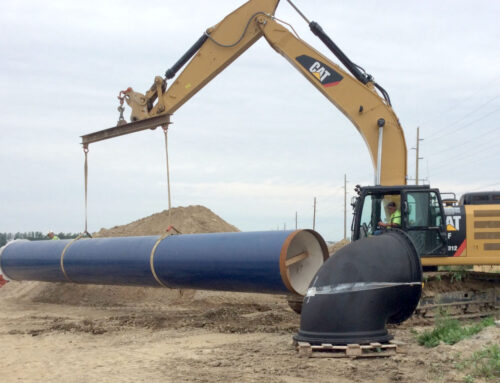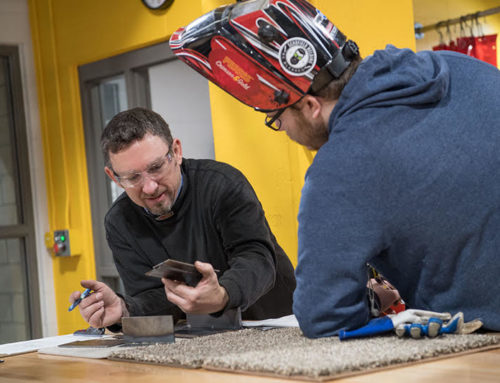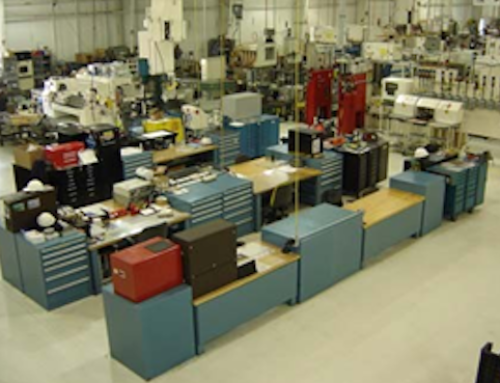By Marchwinski, Chet
7/23/2010
“Double Axel” isn’t about to join “muda” or “takt” in the lean lexicon, but figure skaters perfecting jumps and Lean Thinkers perfecting operations now share a common tool for continuous improvement.
The tool is Dartfish motion analysis software, which is often used by coaches and figure skaters, as well as many other athletes, to record and precisely analyze performance.
The incongruous connection between making the lean leap and nailing a double axel jump began three years ago at a skating rink near the Nexteer Automotive plant in Saginaw, MI. One night after work, while watching his daughter and other competitive figure skaters practice, David Westphal, director of global lean manufacturing at the auto supplier, had an epiphany as the kids and coaches immediately analyzed jumps with Dartfish.
“People learn by seeing,” Westphal said. “So a kid does a jump, but doesn’t land it. The coach has her come over to a laptop and says, ‘Look at this, your hand was out too far, or your leg wasn’t where it belonged, or your timing was off.’ So the skater makes the mental connections right away and makes the corrections.”
Westphal realized that the three elements the software relied on —time, motion, and quality—were relevant to the performance of the plant floor as well as in sports.


After a discussion with Vince DeZorzi, Nexteer’s vice president of manufacturing, Driveline Business Unit, the auto supplier collaborated with Dartfish on how to use the software to analyze industrial process performance. “The idea was that if a process was not performing the way Nexteer wanted, we could discover the problem and how to correct it fast,” Westphal explained.
“In today’s global economy, the marketplace competition is exceptionally intense – very much like the intensity of competition among world-class athletes and race teams,” said DeZorzi. “Using every available tool like Dartfish to provide us not only a technical advantage, but a significant competitive edge is how we think and perform within our businesses. I like to think of it in this way – Nexteer has taken the concept of lean manufacturing and kaizen into the digital age. After all, our Nexteer manufacturing mission is to ‘relentlessly execute to win.’ ”
A big factor in the decision to experiment with Dartfish’s was its relatively low cost compared to conventional motion analysis technology, according to Westphal. “Traditionally you need high-speed cameras that are $10,000 to $50,000 and require an awful light of light, so they are not always conducive to an industrial environment.”
Pixel Power
Equipped with a Windows laptop, basic $300 digital camcorder, and $5,000 software license, a member of Westphal’s lean improvement team could analyze any machine or human motion, such as an automated machine misloading a part or an operator using unsafe or unproductive motions. No software modifications were needed, but Dartfish trained a member of Nexteer’s improvement team as a technical resource.
Victor Bergonzoli, Dartfish CEO, said Nexteer is the first industrial company in North America to use the technology. A tire maker and a couple of watch manufacturers in Europe use it for process analysis. Since it began about 10 years ago, the company has primarily focused on sports applications, he said. Headquartered in Fribourg, Switzerland, Dartfish has offices in Atlanta, Sophia-Antipolis (France), Sydney, Tokyo, and Seoul.
Nevertheless, Dartfish’s tools are at home on the shop floor as well as the ice rink. For example, “tagging” an action can be used to measure the angle of a skater’s back as she begins a jump or that of an operator bending to move a box of parts.
A cutting edge tool like Dartfish also fit with the new image being burnished by Nexteer, a maker of advanced steering and drive train products that emerged from the bankruptcy of Delphi Corp.’s Global Steering Division. “Nexteer is a new company,” said Westphal. “We want people to know we’re state of the art. We’re aggressively pursuing lean and leveraging cutting edge technology to be a better supplier.”
Nexteer estimates it had used the motion analysis software approximately 150 times by mid 2010, mostly at kaizen events, saving several hundred thousand dollars in process and machine improvements. “It’s allowed us to get an insight into everything from human kinematics, to machining mechanics, to lean processing—literally any place where you have motion,” Westphal said. “We’ve applied it a lot in ergonomics. You can attach data to people to analyze the angle of a bending move.” Here are other examples of how Nexteer has used motion analysis:
Safety
A team used Dartfish to record the operation of a machine that was causing minor cuts to operator’s fingers when they removed stringers of chips formed in a tooling insert. Slow motion video revealed the chip formation. “We adjusted the feeds and speeds, dropped the rake angle on the tool, and as a result, completely eliminated the risk,” said Westphal.
Operator Performance
“In a production environment, if I have an operator who can’t make takt time and one who can, I can overlay video of the two of them to show the struggling operator, ‘Here’s what you’re doing that’s keeping you from making takt.’ When they see it, they correct it. It’s that simple.

Video also helps less efficient operators correct unconscious, unproductive motions. At one plant, an operator who was not producing to rate allowed a kaizen team to video him, explained Chuck Brinkman, Nexteer lean manager. “Without saying a word to the operator, we showed him the video. He said, ‘I didn’t know I was doing that.’ We could have stayed there all day, trying to explain that he was doing something different.”

Cycle Times
Spaghetti charts digitally generated by the software allow improvement teams to reduce cycle times by precisely analyzing movement. “You do a traditional spaghetti chart with pencil and paper, keeping your eyes on the operator’s motions,” Westphal said. “But you can’t typically grab all the data by watching. Now we set a camera on a tripod and tell the software to follow a determined point on a person’s hand or body to capture every motion in one shot. With this insight, we’ve improved cycle times by 20% to 40%.”
kaizen teams also video work areas to identify the optimal setup for the fewest hand and arm movements. With many of Nexteer’s 22 plants worldwide having takt times below 20 seconds, saving a few seconds makes a big difference.
In one of its most powerful features, Dartfish allows Nexteer to overlay video of machines or operations that are running well with ones that aren’t. In one case, Nexteer recorded three team members at the same operation, and then overlaid their images to show differences in how they performed standard work such as parts setup and quality checks. After the analysis, they achieved a 21% improvement in operational availability,” Westphal said. “More important, the operators were able to work at a more comfortable pace once wasteful motions were eliminated.”
Equipment Repair
With a parts-per-million defect rate in the single digits, Nexteer might be searching for one defect out of thousands of cycles and parts. “Using this technology, we can run the camera on a loop and catch any inconsistencies before problems arise,” Westphal explained. In one case, a team focused on part misloads at a machine that were causing two hours of downtime and 80 pieces of scrap daily. Using motion analysis to catch and eliminate the misloads, produced a 25% improvement in operational availability and reduced scrap. “A lot of motion happens so fast you can’t see it,” Westphal said. “Dartfish slows it down so you can see it.”
Not a Substitute
Despite the success with Dartfish, Westphal cautioned that it isn’t a substitute for learning and rigorously applying lean principles. For example, generating a digital spaghetti chart to achieve a goal of reducing walking time by half is useless unless you know how to reduce the walk time. “You still have to be a pretty smart lean manager to get that walk time down,” Westphal said. “The beauty of Dartfish is that it makes waste so darn visibly clear that you can get to it quickly.”


Westphal sees Dartfish as supporting the base of the Toyota Production System “house” that’s often used to illustrate how the various lean tools fit together to form a business system.
People Reaction
A workforce knowledgeable about sports and at ease with technology has eased acceptance of what could be an intrusive tool.
“People have seen the technology watching NASCAR or sports on TV,” Westphal said. “Maybe didn’t know the name of the tool, but they were familiar with the software from watching sports. I get less resistance from having one of my team members with a camera giving people instant feedback in a cell, than if I had sent in an industrial engineer with a clip board. It’s been very, very well received.”
He estimated that Dartfish is “probably the number one” special tool requested from his improvement team at kaizen events. Part of the appeal comes from its capacity to let a team video a process in the morning, analyze it, make corrections in the afternoon, then re-video the processto validate that the changes actually worked. But part of Dartfish’s appeal may also come from human nature.
Said Westphal, “Once a person sees that they are not doing their best work because they’re not following the best form, they will go right to the best form without being forced. People have an innate desire to do better, and this is a tool that lets them see when they are not doing the best they can.”
For more information
Nexteer: is a global leader in advanced steering and driveline systems. Nexteer Automotive brings a fresh perspective to the automotive supplier industry as a small, agile, and fast company that provides the very latest in advanced steering solutions. As a new company drawing on a 100-year heritage of industry-leading expertise, Nexteer Automotive has a strong foundation and a reputation for producing dependable steering solutions and enduring customer relationships
Dartfish is a high growth, video-centric and customer driven company, which develops applications to use video and video enriched content in professional and communities’ workflows. By providing cutting-edge video and enrichment functionalities in easy-to-use applications, Dartfish makes the power of video accessible and sets the de facto video standard across industries like sports, education, healthcare, and new media. Watch a demo video.
Build Your “House” Of Production on A Stable Foundation . The subject of this related lean management case study, Delphi’s Plant 1, is part of Nexteer. The story remains relevant as a lesson in how to launch a successful improvement effort by focusing on rigorous problem solving to create basic stability in a machine-intensive environment. The case study looks at what plant management, staff and employees did.
The Lean Enterprise Institute (LEI) teaches many of the lean management concepts described above in workshops, Lean Summits, books and workbooks, and on its web site.
Join LEI’s Lean Community for access to case studies, webinars, newsletters, lean management columns and e-letters, and many other resources for starting and sustaining a lean transformation.
Lean Enterprise Institute, Inc., was founded in 1997 by management expert James P. Womack, Ph.D., as a nonprofit research, education, publishing, and conference company with a mission to advance lean thinking around the world. We teach courses, hold management seminars, write and publish books and workbooks, and organize public and private conferences. We use the surplus revenues from these activities to conduct research projects and support other lean initiatives such as the Lean Education Academic Network, the Lean Global Networkand the Healthcare Value Leaders Network. Visit LEI at https://www.lean.org for more information.
Media: Chet Marchwinski, cmarchwinski@lean.org, (617) 871-2930






